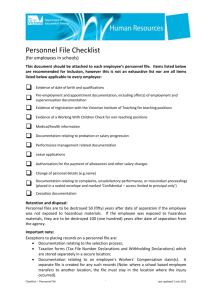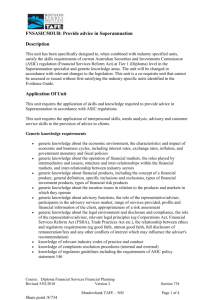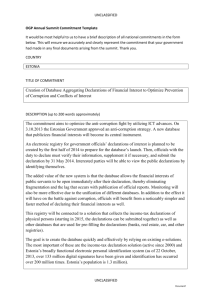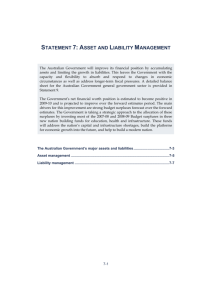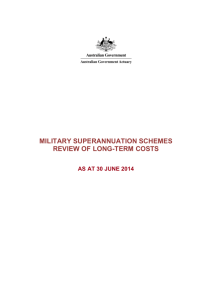Target asset level declarations
advertisement
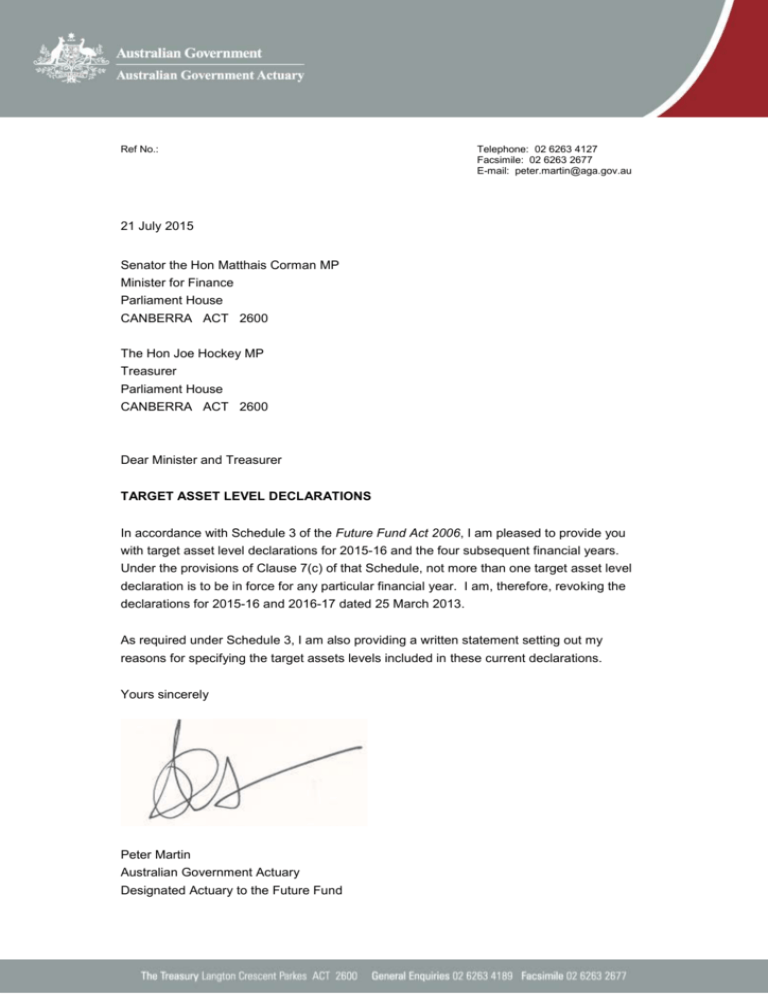
Ref No.: Telephone: 02 6263 4127 Facsimile: 02 6263 2677 E-mail: peter.martin@aga.gov.au 21 July 2015 Senator the Hon Matthais Corman MP Minister for Finance Parliament House CANBERRA ACT 2600 The Hon Joe Hockey MP Treasurer Parliament House CANBERRA ACT 2600 Dear Minister and Treasurer TARGET ASSET LEVEL DECLARATIONS In accordance with Schedule 3 of the Future Fund Act 2006, I am pleased to provide you with target asset level declarations for 2015-16 and the four subsequent financial years. Under the provisions of Clause 7(c) of that Schedule, not more than one target asset level declaration is to be in force for any particular financial year. I am, therefore, revoking the declarations for 2015-16 and 2016-17 dated 25 March 2013. As required under Schedule 3, I am also providing a written statement setting out my reasons for specifying the target assets levels included in these current declarations. Yours sincerely Peter Martin Australian Government Actuary Designated Actuary to the Future Fund 2 Target asset level declaration In accordance with Schedule 3 of the Future Fund Act 2006, I, Peter Colin Martin, FIAA and Australian Government Actuary, being the Designated Actuary to the Future Fund, declare the following amounts as the target asset levels for the following years: 2015-16 $154.9 billion 2016-17 $161.1 billion 2017-18 $167.5 billion 2018-19 $173.9 billion 2019-20 $180.4 billion Statement of Reasons for Specifying the Target Asset Levels The target asset levels specified in the document dated 21 July 2015 have been determined on the basis that they are my best estimates of the present value at the start of the relevant financial year of the Commonwealth’s projected unfunded superannuation liability (as that term is defined in the Future Fund Act 2006) in respect of services rendered before the start of that year. This liability arises under the following schemes (listed in descending order of size of liability as at 30 June 2014): • the Commonwealth Superannuation Scheme (CSS) covering benefits paid under the Superannuation Act 1922 or the Superannuation Act 1976; • the Public Sector Superannuation Scheme (PSS) covering benefits paid under the scheme established by the Superannuation Act 1990; • the Defence Force Retirement and Death Benefits Scheme (DFRDB) covering benefits paid under the Defence Force Retirement and Death Benefits Act 1973; • the Military Superannuation and Benefits Scheme (MSBS) covering benefits paid under the scheme established by the Military Superannuation and Benefits Act 1991; • the Judges’ Pension Scheme covering benefits paid under the Judges’ Pensions Act 1968; • the Parliamentary Contributory Superannuation Scheme (PCSS) covering benefits paid under the Parliamentary Contributory Superannuation Act 1948; • the Defence Forces Retirement Benefits Scheme (DFRB) covering benefits paid under the Defence Forces Retirement Benefits Act 1948; and • the pensions provided for former Governors-General under the Governor-General Act 1974. For the purposes of preparing the declarations, I have assumed that the Judges’ Pension Scheme will remain open to new members. In the 2014-15 Budget, the Government announced that the MSBS would be closed to new members from 1 July 2016 and that, from that date, new permanent ADF members and new continuous full-time Reservists would have their retirement benefits provided under a fully funded accumulation scheme to be known as ADF Super. The relevant legislation was introduced into Parliament on 25 June 2015. Accordingly, for the purposes of preparing the declarations I have assumed that the MSBS will be closed to new ADF members who commence service on or after 1 July 2016. I have further assumed, for the purposes of preparing the declarations, that no MSBS members will (elect to) transfer to ADF Super. Finally, as the legislation also includes changes to the Future Fund Act 2006, I have assumed 1 that the unfunded superannuation liability will include the costs arising under a scheme to be known as ADF Cover which will be introduced from 1 July 2016 and which will provide unfunded death and disability benefits to ADF members covered by the new accumulation scheme. I have assumed that the benefits to be provided under ADF Cover will be similar to the unfunded death and disability benefits currently provided under the MSBS. Formal actuarial reviews as at 30 June 2014 were conducted on each of the above schemes over 2014-15. The reviews involved analysis of the experience of the schemes over the preceding three years and selection of demographic assumptions which reflected that experience and other information which might provide guidance on future behaviour. I have retained the demographic assumptions from those reviews in arriving at the estimates of the projected unfunded superannuation liability. The 2014 actuarial reviews of the schemes used the following economic assumptions: • pension indexation rate for the CSS, PSS, MSBS and for DFRDB pensioners who are aged less than 55 2.5% per annum pension indexation rate for the remaining schemes and for DFRDB pensioners who are aged 55 or more 4.0% per annum • non-promotional wage growth for all schemes 4.0% per annum • discount rate for all schemes 6.0% per annum • The pension indexation and wage growth assumptions are consistent with Treasury views on the medium to long term macroeconomic outlook and I have retained them for the current purpose. The target asset level for a particular financial year is intended to be my best estimate of the funds that would be required in order that, together with investment earnings on those funds, they would be sufficient to meet future benefit payments in respect of service rendered before the start of the year. As such, the valuation discount rate needs to represent the expected investment return on Future Fund assets. therefore, had regard to: In selecting the valuation discount rate, I have, • the investment mandate for the Future Fund as set out in the Future Fund Investment Mandate Directions 2006; • investment performance to date, both before and after investment expenses; • the assumed long term rate of growth in the CPI of 2.5 per cent per annum; • current global economic conditions which feature real interest rates that are abnormally low by historical standards; • the investment policy and strategy of the Future Fund; • the likelihood of drawdowns from the Future Fund following 30 June 2020; 2 • discussions with the Future Fund Management Agency regarding expectations of future earnings; and • the valuation discount rate adopted for the previous target asset level declarations. The Future Fund has outperformed its investment mandate over recent years. In part, this is related to falling interest rates and the associated repricing of assets. Real interest rates have fallen further since March 2013, when I last made target asset level declarations, and there is little scope for future returns to be boosted through this mechanism. Conversely, an increase in real interest rates would be expected to depress asset prices, thus reducing expected future returns. As a result, expected future real returns may now be somewhat lower than in 2013. After taking account of these matters, I have selected a valuation discount rate of 6.5 per cent per annum. Although this is 0.7 per cent per annum lower than the discount rate assumption of 7.2 per cent per annum adopted for the previous target asset level declarations dated 25 March 2013, the current assumption remains consistent with the Future Fund mandate, when the high returns over the two years since 30 June 2013 are taken into account. For the CSS, DFRDB, PSS, MSBS, Judges’ Pension Scheme and the DFRB, I have relied on projections of the unfunded liability prepared by the scheme actuaries using the assumptions described above and membership data as at 30 June 2014. For the PCSS, I have relied on the projections prepared by the scheme actuary using the assumptions from the 2014 review and membership data as at 30 June 2014. I have then adjusted these projections to take account of the higher valuation discount rate being used for the current purpose. I have relied on projections of the unfunded liability of ADF cover prepared by the MSBS scheme actuary. Together, the projections prepared by the scheme actuaries account for virtually all of the total unfunded superannuation liability. More approximate methods were used to estimate the small remaining component. 3
